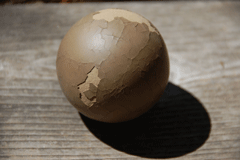The Art of Mud
Air Date: Week of August 21, 2009

An imperfect mudball. (Photo: Bethany Ericson)
When commentator Bethany Ericson’s adult brother had some time on his hands, he decided to take up the Japanese craft of making perfect balls of mud. But his sister says the interest soon turned to obsession.
Transcript
CURWOOD: Playing in the mud can be great summertime fun…but for commentator Bethany Ericson …her brother went too far.
ERICSON: Last summer, my brother had a thing for mud. What's unusual about this is that my brother is a 41-year-old academic.
One minute he was reading random articles online, and the next he was transfixed with the dirt in his yard.
He'd read that Japanese schoolchildren were going through a craze of making perfect mud balls in playgrounds.
These mud balls, called hikaru dorodango, aren't just balls of wet soil. They're perfectly smooth, dry balls encased in a glossy shell. Supposedly patiently layering mud, then burnishing it with fine dirt can achieve this, and my brother was determined to find out.
Neither of us had ever made a ball of dirt look like a polished marble when we were kids. Nor had anyone we knew heard of a dorodango. My brother lives in a tiny, forested town with dial-up internet service, but he was intrigued enough to sit for ten minutes stabbing at pop up ads just to carefully watch a video of someone stroking a handful of mud.
The obsession took hold. He no longer talked about the books he had just read, or even the other art he'd created. Instead he’d enlighten us about the best patches of dirt in a two-mile radius. The old plastic post office mail bin in his living room that had once held poetry manuscripts was now full of what he called the "good dirt." His worn tan Carhardts took on a gray tinge, and his hands mechanically formed everything he picked up into a sphere.
My brother refused to be out-balled by Japanese toddlers. Each stage of his day became carefully metered out into the minutes of layering, the half hour of moisture controlled curing in the fridge, the hour of dusting with fine clay. He stayed up late, patting and rounding.
The more involved he got, the more he failed.
He invited everyone to join him. We all made excuses. We found ways to bring up people we knew who were obsessive compulsive, and then we'd stare at him pointedly as he cradled a mug of coffee in one dirt-lined hand and a mud ball in the other.
Each of his days ended with a glimpse of pride and hope: several shiny dorodango nestled together on a Frisbee. Every morning they were shattered.
Finally in the fall, my brother literally washed his hands of the whole affair. Perhaps his lesson was in resolve, or perhaps just rumination. Maybe he could have opened up a meditation retreat, where people would pay to walk around slowly all day, massaging a mud orb. But instead he got emotionally involved, and in the end the mud balls were good for one thing: throwing.
Anyway, my brother is moving forward. Now he's into rocks.
[MUSIC: Dr. John “Mississippi Mud” from Dr. John Plays Mac Rebennack: The Legendary Sessions Vol. 2 (Clean Cut Music 2006)]
CURWOOD: Bethany Ericson is a writer and artist from Cambridge, MA.
Living on Earth wants to hear from you!
Living on Earth
62 Calef Highway, Suite 212
Lee, NH 03861
Telephone: 617-287-4121
E-mail: comments@loe.org
Newsletter [Click here]
Donate to Living on Earth!
Living on Earth is an independent media program and relies entirely on contributions from listeners and institutions supporting public service. Please donate now to preserve an independent environmental voice.
NewsletterLiving on Earth offers a weekly delivery of the show's rundown to your mailbox. Sign up for our newsletter today!
 Sailors For The Sea: Be the change you want to sea.
Sailors For The Sea: Be the change you want to sea.
 The Grantham Foundation for the Protection of the Environment: Committed to protecting and improving the health of the global environment.
The Grantham Foundation for the Protection of the Environment: Committed to protecting and improving the health of the global environment.
 Contribute to Living on Earth and receive, as our gift to you, an archival print of one of Mark Seth Lender's extraordinary wildlife photographs. Follow the link to see Mark's current collection of photographs.
Contribute to Living on Earth and receive, as our gift to you, an archival print of one of Mark Seth Lender's extraordinary wildlife photographs. Follow the link to see Mark's current collection of photographs.
 Buy a signed copy of Mark Seth Lender's book Smeagull the Seagull & support Living on Earth
Buy a signed copy of Mark Seth Lender's book Smeagull the Seagull & support Living on Earth

